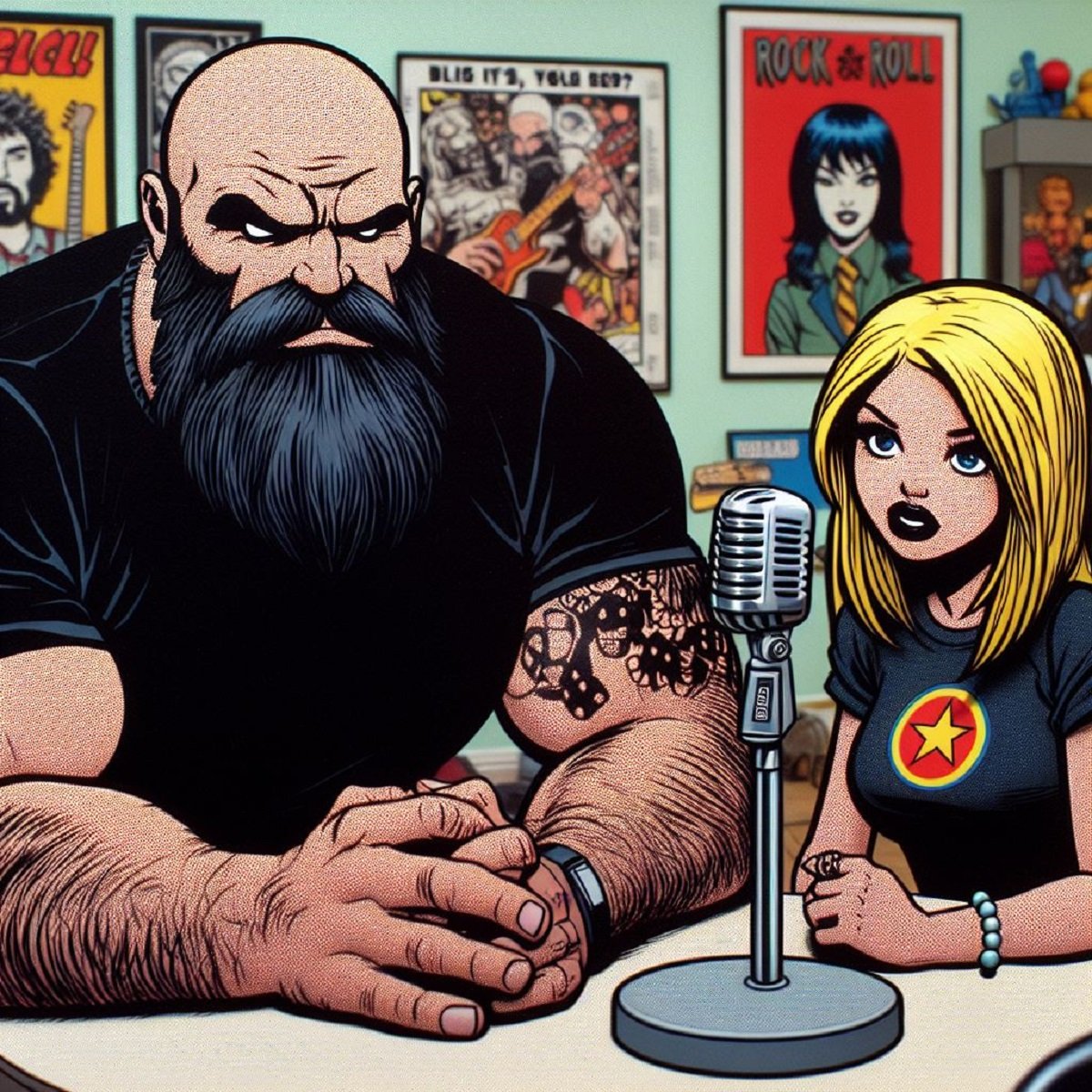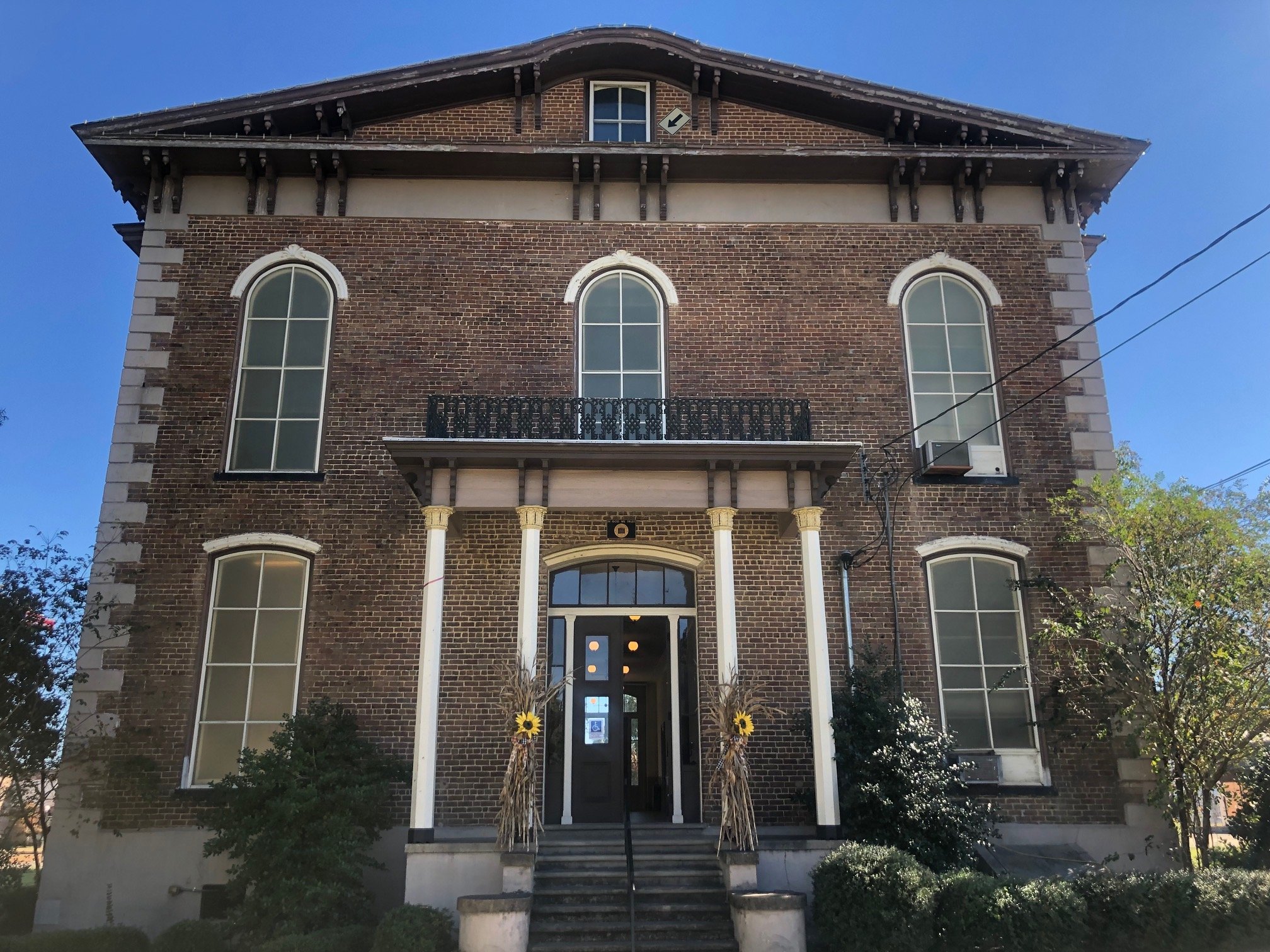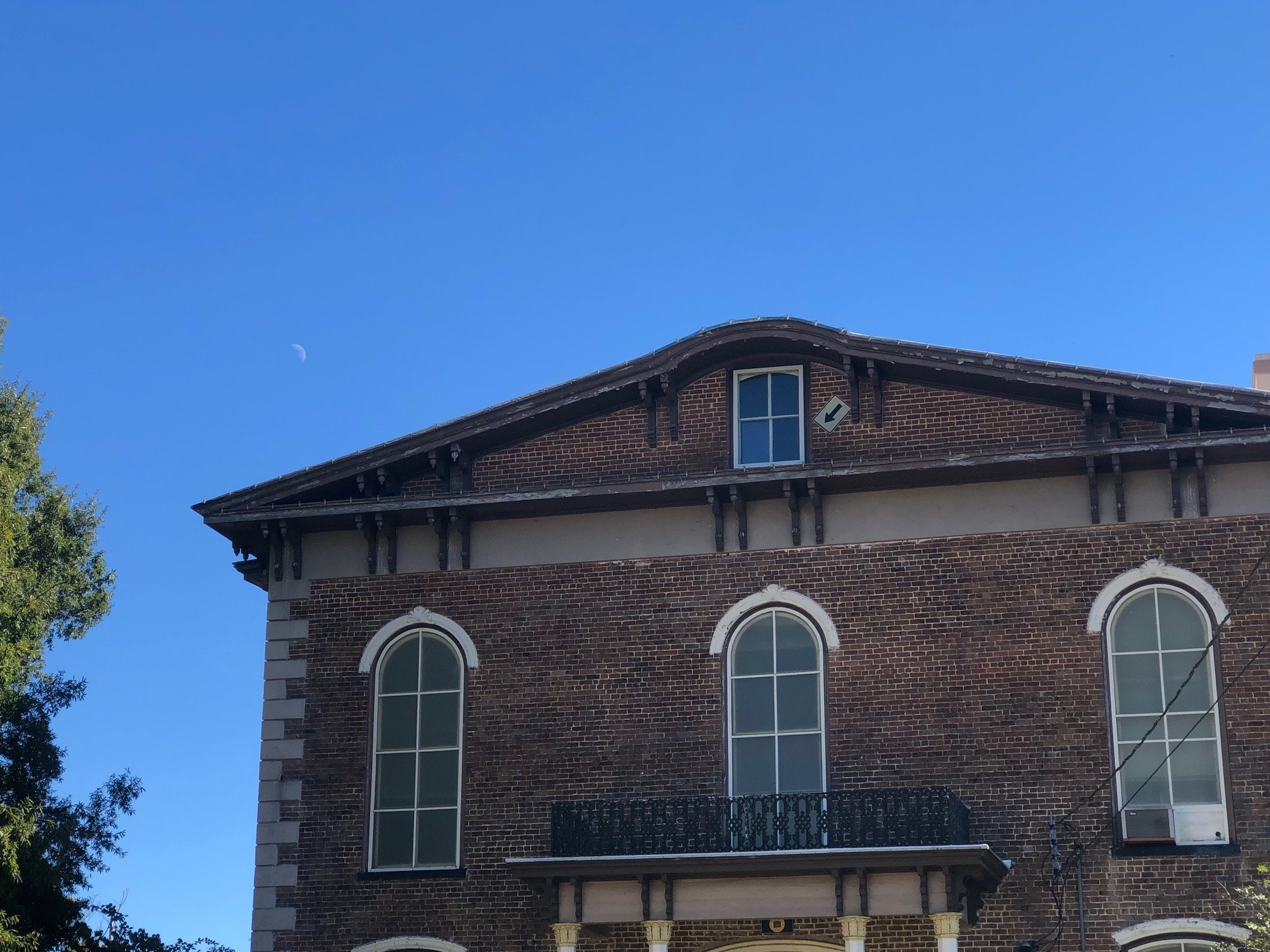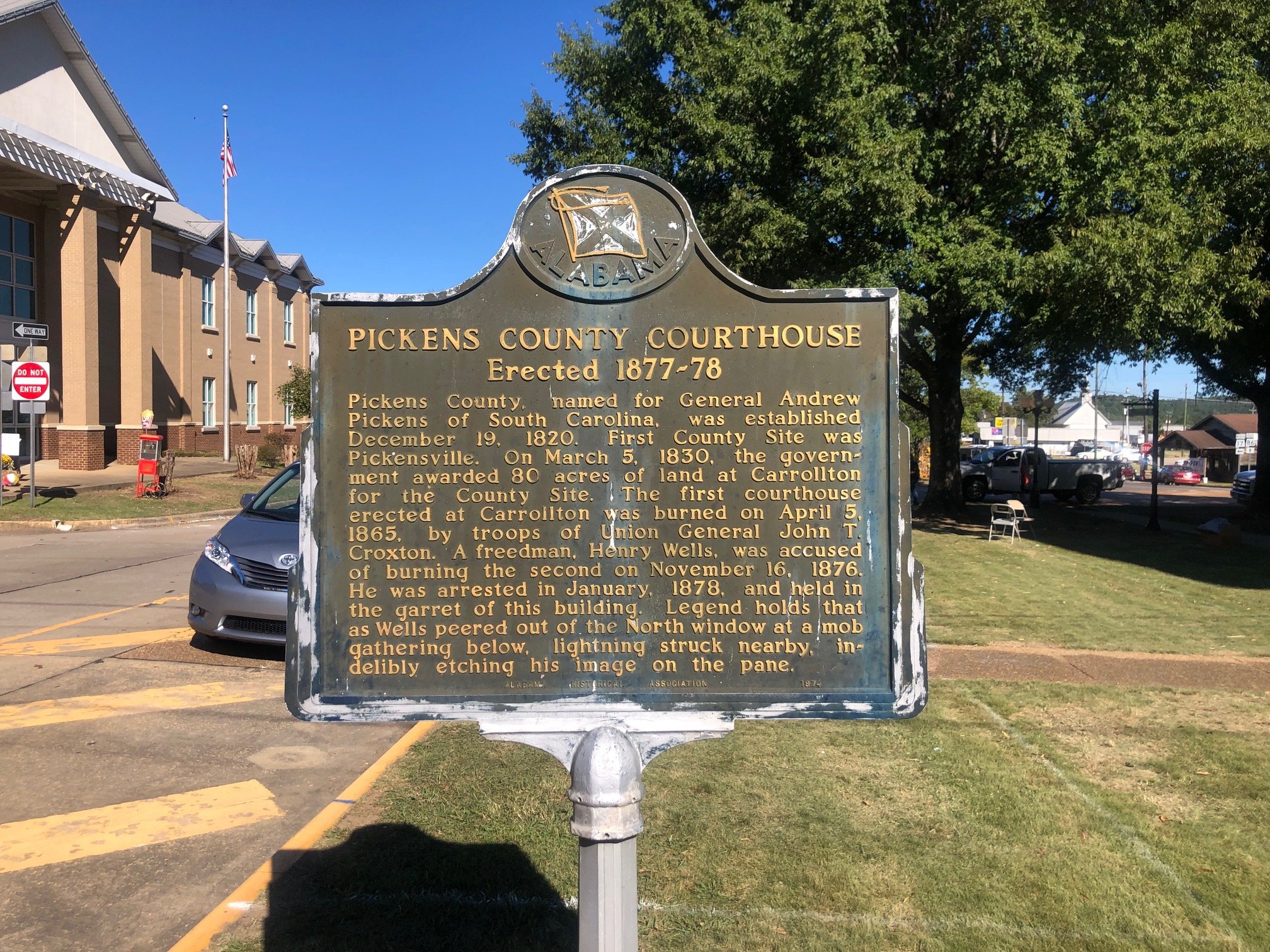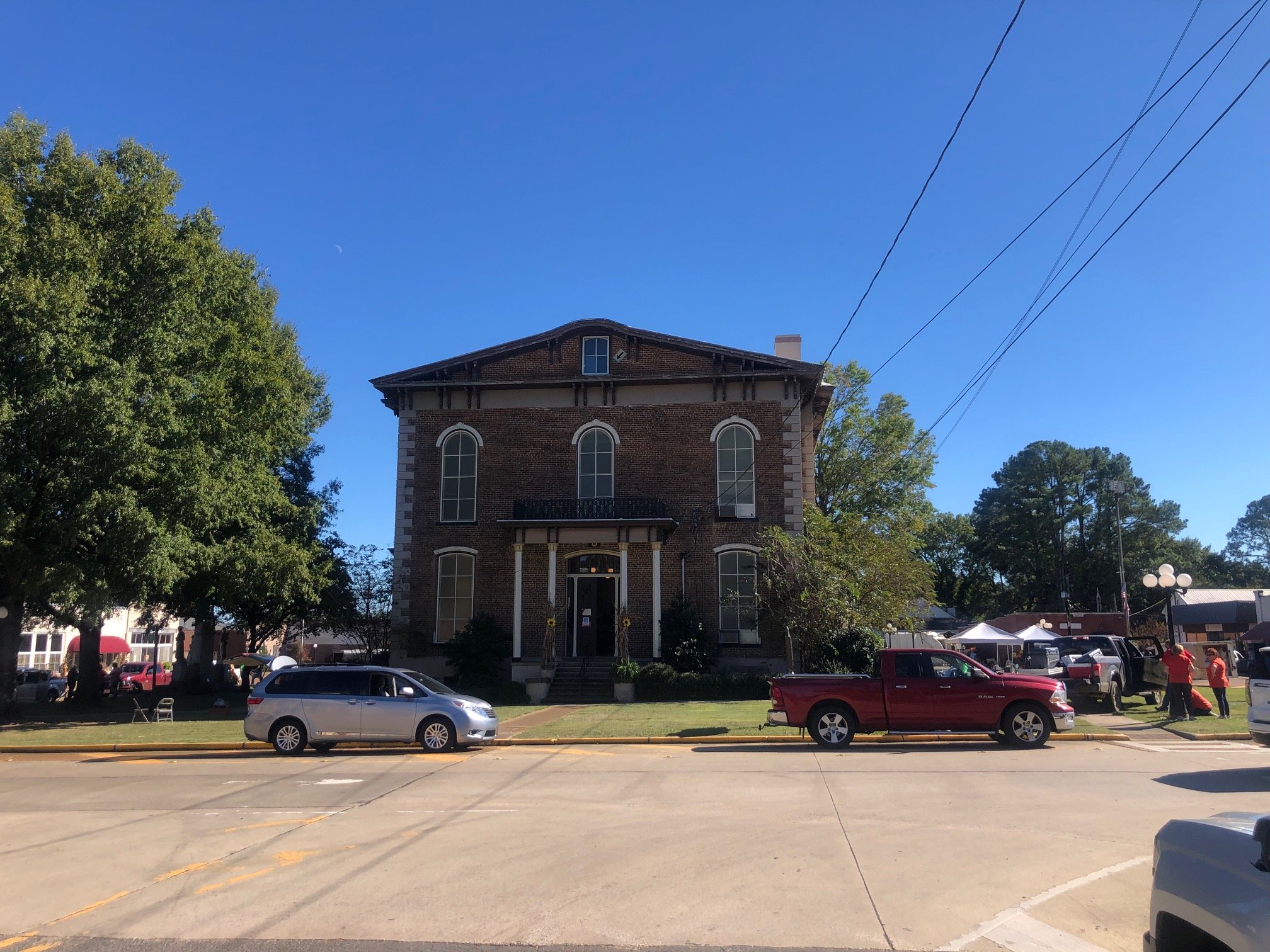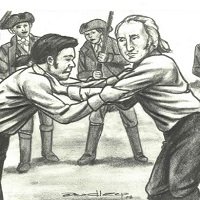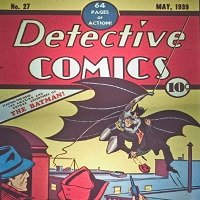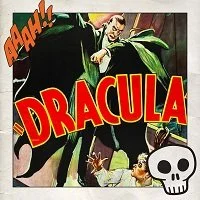The Face in the Court House Window. The Story of the Pickens County Alabama Courthouse Ghost Story
By: Karl Stern (Patreon)
The Pickens County Courthouse in Carrollton, Alabama. (Photo by Karl Stern)
The “Face in the Courthouse Window” is a famous Alabama ghost story which you can still see evidence of today. The story of the Pickens County, Alabama courthouse window has been chronicled in such books as 13 Alabama Ghosts and Jeffery by Kathryn Tucker Windham. Karl and Tonya from When It Was Cool traveled to Carrollton, Alabama on October 1, 2022 to see the face for themselves and to take a tour of the old Pickens County Courthouse.
The story of Henry Wells and the face in the courthouse window differs in some details depending on where it is chronicled, but the website The Face in the Courthouse Window tells it this way, “On January 30, 1878, as storm clouds grew and rain began to pour, Henry Wells was looking down from the garret roof of the Pickens County Courthouse at a mob bent on lynching him. In a flash, a bolt of lightning struck a nearby tree and arched across to the Courthouse where Wells was standing. His anguished features are still visible in the glass of that garret room today.
The legend surrounding Henry Wells and the 1876 burning of the Pickens County courthouse has been local folklore for years. The details remain clouded, but there are a few things we know for sure from court records and news articles that were preserved from this time period. In 1876, Pickens County’s newly erected courthouse burned to the ground, just as the original structure had done 12 years earlier at the hands of Union soldiers under the command of General John T. Croxton - as they passed through Carrollton on their way from Tuscaloosa after burning the University of Alabama.
Circuit Court minutes show that Henry Wells, a freed slave living in Carrollton (Providence Beat), was accused and convicted of the act. Two years after the courthouse burned, Wells was apprehended in Fairfield, Alabama (South of Aliceville) and died soon after his arrest from gunshot wounds sustained while attempting to flee authorities. And finally, we know that for 130 years since his death, individuals looking up at the courthouse have witnessed an eerie image peering out from the structure’s upper window. Even today it remains a ghostly reminder of Wells’ supposed threat in protest to his arrest — that being, to haunt his accusers for the rest of their lives.”
A cresent moon shines down on the Pickens County Courthouse in Carrollton, Alabama as an arrow points to the famouse Face in the Courthouse Window. (Photo: Karl Stern)
However, Wikipedia offers a different explanation for the story and the face.
“The story of Henry Wells' face in the courthouse window seems to have been a conflation through the myth of two historic events, that of the lynching of a white man named Nathaniel Pierce, and that of the arrest and shooting of an African American man named Henry Wells. He later confessed to burning down the courthouse, likely under coercion, and died of his wounds. White guilt may have contributed to the account of Wells cursing the town and threatening they would be haunted by him…
…According to the West Alabamian, which was Carrollton's only newspaper at the time of the events, Nathaniel Pierce was being held on charges of murder when, on September 26, 1877, an armed mob forced their way into the jail where he was being held, took him outside the city, and lynched him. Pierce's lynching was not reported as having anything to do with the burning of the courthouse.”
The handcuffs which supposedly held Henry Wells are on display at the Pickens County Courthouse. (Photo: Karl Stern)
Wikipedia continues, “The whites in town already suspected Henry Wells and an accomplice, Bill Buckhalter, of the arson. A story in the West Alabamian on December 13, 1876, said that Wells and Buckhalter were also suspected of robbing a store on the night in 1876 when the courtroom was burned. The newspaper reported that stolen merchandise from the store was found in their homes. But that supports their part in the robbery, not arson.
Buckhalter was arrested in January 1878. He confessed to the burglary and blamed Wells for the burning of the courthouse. Wells was caught a few days later. When confronted by the police, he tried to flee and was shot twice. He confessed to burning the courthouse, likely under coercion, including beatings. He died from his wounds five days later.
These two events appeared to have been combined into the commonly told myth of how a face appeared in the courthouse window, but neither Pierce nor Wells could have been the "face in the window." Both Pierce and Wells died before the windows were installed in the new courthouse. The West Alabamian reported that windows were being installed in the courthouse on February 20, 1878. These windows were the windows in the main courtroom, which were the first windows installed to prepare for a court session scheduled in the middle of March. The garret windows, including the one with the ghostly face, were not installed until weeks after Wells' death.
The face itself appears in the lower right hand pane of the Pickens County Courthouse.
“What follows is the commonly told myth of how the face was etched into the window.
On November 16, 1876, the people of Carrollton, Alabama watched as their courthouse burned to the ground. The Pickens County Courthouse had been a source of pride for them. Their first courthouse had been burned down by invading Union Army troops during the American Civil War. In the difficult days of the Reconstruction, when materials were scarce and money was even scarcer, rebuilding the courthouse seemed to be an impossible task. Yet, through hard work and deep personal sacrifices by residents, the courthouse was rebuilt. It stood as a symbol of defiance in the face of defeat by the Union.
Fewer than twelve years after Union troops had set fire to the town's first courthouse, the new one burned in 1876. Some said it was a burglary gone wrong. Even as work began on a third courthouse, the townspeople demanded vengeance for the arson. Despite the lack of circumstantial evidence, they identified Henry Wells as a suspect; he was a freedman who lived near the town.
Henry Wells was said to have a horrible temper, and he had been involved in several brawls. People said he constantly carried a straight razor and was not afraid to use it. Despite these rumors, however, there was only vague circumstantial evidence against him in the burning of the courthouse… Henry Wells was charged and arrested on four counts: arson, burglary, carrying a concealed weapon and assault with intent to murder. He was taken to the sheriff's office, located inside the newly completed courthouse, to await trial.
As word spread through the town of Wells' arrest, the sheriff could sense trouble brewing. As the first few drunken men began heading toward the courthouse, the sheriff took Wells to its high garret and told him to keep quiet. But as the angry mob gathered below, Wells' fear got the best of him. He went to the window and looked down on the crowd. He yelled defiantly, "I am innocent. If you kill me, I am going to haunt you for the rest of your lives!" Just then, a bolt of lightning struck nearby, flashing the image of Wells' face, contorted with fear, to the crowd below.
The lynch mob forced its way into the courthouse, and took their victim outside, even as he continued to proclaim his innocence. They killed him.
Early the next morning, as a member of the lynch mob passed by the courthouse, he happened to glance up at the garret window. He was shocked to see Wells' face looking down at him, just as it had the night before when it had been illuminated by the flash of lightning. He rubbed his eyes and cursed his hangover, but when he looked back up, there was Wells. He screamed, and as others arrived, they all remembered Wells' prediction. "If you kill me, I am going to haunt you for the rest of your lives!"
The face remains in the courthouse window to this very day. No amount of washing has been able to remove it. On at least one occasion, it is said that every window pane in the courthouse was broken by a severe hailstorm; every pane, that is, except that with Wells' face.
Another local version of this story is that while Wells was awaiting trial for being falsely accused of raping a white woman (a common accusation in lynchings), a lightning storm brewed, and an angry mob gathered below to lynch him, and he told them, "If you lynch me, you will forever see my face." At this time lightning struck the very window in which he was standing. From that day forward, no amount of washing, or replacing that window, has been able to remove his face.”
If you found this article interesting consider becoming a Patreon supporter. That is how When It Was Cool keeps our website and podcasts online, plus you get lots of bonus content including extra and extended podcasts, articles, digital comics, ebooks, and much more. Check out our Patreon Page to see what's up!
If you don't want to use Patreon but still want to support When It Was Cool then how about a one time $5 PayPal donation? Thank you!
